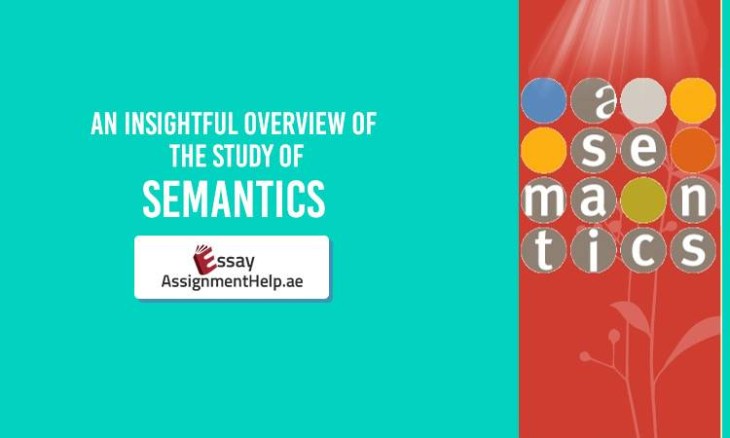Blog >>An Insightful Overview Of The Study Of Semantics
Dipika Published On Feb 14, 2018 | Updated on Apr 10, 2023
Dipika Published On Jun 12, 2019 | Updated on Apr 10, 2023
Dipika Published On Apr 5, 2018 | Updated on Apr 10, 2023
Dipika Published On Apr 6, 2018 | Updated on Apr 10, 2023
Thank you for subscribing our newsletter

An Insightful Overview of the Study of Semantics
Semantics refers to the branch of linguistics and logic backed by meaning. There are basically two main areas associated with the subject of Semantic, namely, namely logical semantics and lexical semantics. However, getting the hang of this basic semantics definition isn’t sufficient for an individual who wants to get into the nitty-gritty details of the subject matter.
So, let’s delve deeper for further details.
Happy reading!
What is Semantics? An Extended Overview
Semantics is the study of the link between words and how we draw meaning from those set of words. The process of semantics involves the deconstruction of words, sentence structure and signals. This impacts our reading comprehension as well as comprehension of other people’s usage of words and phrases in daily conversation. Semantics carry different theories, such as:
- Formal Semantics: Formal semantics use techniques from philosophy, math and logic in order to understand the broader connection between possibility, truth, reality and language.
- Lexical Semantics: Lexical semantics deconstruct phrases and words within a line of text to get the hang of the meaning in terms of its context. Lexical semantics can include a study of individual nouns, adjectives, verbs, suffixes, prefixes, root words and idioms.
- Conceptual Semantics: This particular branch of semantics deals with the most basic concept and form of a word prior to our thoughts or feelings add context to it. For example, the word “bark’ may refer to the context of “dog bark”. On the other hand, the word also refers to the context of “tree bark”.
A Brief History of Semantics
Semantics was first used by Michel Breal, a French philologist in 1883. Semantics was used as a device that can be used in order to describe how words can carry different meanings for different words. Here are some of the most crucial aspects that define and outline the foundation of Semantics.
- A language can be a natural language. For example, French, Dutch or Mandarin.
- Languages can be artificial as well.
- Theoretical scientists study and develop artificial languages, while linguists study natural languages.
Talking of the history of Semantics, in the year 1967, Robert W Floyd, wrote a paper that defined what are semantics. Here are the key elements of Floyd’s work. Take a look.
- Analysis and design of algorithms that are used in order to find the most efficient paths in the network, the parsing of programming language, the calculation of quantities, and the sorting of information.
- According to Floyd, programming languages are being made up of two parts. Namely, Semantics that denote meaning and Syntax that denotes form.
The History of Semantic web vs. The World Wide Web
The feature article The Semantic Web, published in the year 2001 and authored by Tim Berners Lee, Ora Lassila and James Hendler talked about the following aspects of Semantic Web and the World Wide Web.
The article talked about a different way to use and search the internet. Additionally, it included a completely new dimension to the concept of web and semantics.
More about the History of Semantics
If we go back to the historical journey of Semantics, here are a few more facts that will intrigue you.
- It is said that Alfred Korzybski was the first person to attempt studying Semantics as a unique sub-discipline, quite different from the conventional disciplines of Philosophy,
- Before Korzybski, Semantics was considered a subject looked from a non-scientific point of view.
- Korzybski came and attempted at bringing forth a scientific model to the study of semantics.
Now that you know where it all started, backed by the brief yet insightful history of the subject of Semantics, let’s take a look at how it is studied.
How is Semantics Studied?
In linguistics, semantics refers to the subfield that is dedicated to the study of meaning. To study semantics, one needs to develop a thorough knowledge of the different fundamentals of language.
There are key dimensions one must consider while studying this particular subject. Let’s take a look at the same.
- First things first, you need to get the hang of the conventions of linguistics.
- The concept of syntax trees can also be used as one of the effective means of studying semantics.
Talking of using the concept of syntax trees to study semantics, the sub-discipline uses theoretical knowledge of how language works on a wider realm to explain and decode how meaning works.
Here’s a semantics example showing how an ambiguous can be explained using tow syntax trees.

The aforementioned example explains how different meanings affect grammar of a particular sentence with the help of two distinct trees showing how meaning impacts grammar.
Why is Semantics Studied?
Semantics, as a subject, has different definitions in the domain of Science and in Natural Language Processing as well. The sub-discipline is pursued by students across the globe due to a lot of reasons. Let’s take look at the most notable ones.
- The study of semantics allows individuals to analyze how language is used both literally and figuratively in order to produce meanings.
- Studying semantics helps scientist gain an in-depth understanding of how language is learned an implied in various fields of scientific learning and application.
- The subject further explains the different types of meaning that exists within a particular sentence.
- The study of semantics is considered critical due to the way it allows academicians and scientists to link the application and significance of language to other disciplines.
Now that you know why is Semantics studied, let’s move on to the next section and explore the developmental timeline of the subject.

The study of Semantics dates back to the year 1960. However, the developmental phase continued till 1980, and is said to expand its base and application in the present day as well.
Let’s take a look at its journey.
1960s
- Proposal of Richard Montague's system for defining semantic entries: This particular entry presents the origin of Montague semantics. In the late 1960s, Richard Montague proposed a system that defined semantic entries in the lexicon. Montague explained that the meaning of a particular sentence could be decomposed into the meanings of its segments an in a few rules of combination.
- Debut of the Montague Grammar: Eventually, the Montague grammar was introduced, which was limited by the context-dependent variability. This, as a result, led to several attempts at incorporating the theory in the years that followed next.
- Rise of Noam Chomsky's theory of Generative Linguistics: American linguist Noam Chomsky first used the term “Generative Linguistics in relation to the concept of theoretical linguistics of grammar which was developed by him in the late 1950s. Linguists who followed the theory thenceforth were called generativists.
- Chomsky's influential Universal Grammar: Chomsky argued that the human brain comprises a limited set of constraints in terms of organising language. His influential theory of universal grammar implies that all languages have a common structure which sets the basic rules, also known as “universal grammar”.
1970s
- Eleanor Rosch's Prototype Theory: Eleanor Rosch, a professor of Psychology at the University of California introduced this prototype theory by supporting the notion that meaning is
not objective, it is learned through experience. The theory has also been applied in the domain of linguistics, as part of the mapping from phonological structure to semantics.
- William Labov linguistics theory VS Noam Chomsky's linguistics theory: William Labov’s linguistic theory approached to investigate the relationship between language and society. On the other hand, Noam Chomsky’s linguistics theory comprises both surface structures and deep structures. His theory of grammar and language is often referred to as “generative, “transformational” or “transformational generative” theory.
- William Labov supported that what should be studied is E Language instead of I language: E language stands for “External”, and refers to the observable language outside people’s mind. Whereas, “I” stands for “Internal” and refers to the internal linguistic knowledge acquired by every human. However, William Labov supported the notion that one should study E language and investigated the relationship between language and society with his theoretical approach.
1980s - Present Day
- Semantic research still goes on: Even though various scientists and linguists began their quest for evaluating the various theories of semantic, the research still goes on. Metadata and Semantic research at the 4th International Conference (2014) and 11th International Conference (2017) indicate the fact that theorists across the world are constantly working on the scopes and application of Semantics.
- Late 1990s: Lexical Semantics emerged: The latter half of 1990 marked the emergence of Lexical Semantics. It was discovered as one of the major sub-fields of Semantics.
- George Lakoff and Ronald Langacker contributed to the world of Semantics with their Cognitive theories: Cognitive linguistics literally saw the light of the day due to these two notable linguists. Lakoff coined the term “cognitive” in the year 1987, in his book, “Women, Fire, and Dangerous Thing”. On the other hand, Langacker made his presence felt by creating cognitive grammar.
- David Crystal contributed to the newest major fields of study in Linguistics: David Crystal is regarded as a proponent of a new field of study, “internet linguistics”. His book “Language and the Internet” published in the year 2001, and “Txtng: The Gr8 Db8”, published in the year 2008 focused on new-age text language and its impact on the society.
Are still unclear of semantics definition a few concepts related to general semantics? Connect with us during any time of the day, for the best academic support on the go.
Consult EssayAssignmenthelp.ae for Flawless Semantics Assignment Help
Assignments on Semantics are tough nuts to crack unless you are aware of its nitty-gritty. In case you are stuck with an overly complicated assignment topic on Semantics, refrain from keeping your mind occupied and get in touch with us at the earliest. EssayAssignmenthelp.ae is right here to provide you with comprehensive Semantics assignment help on time.
We have hired some of the diligent academic writers holding verified degrees in the subject of Linguistics from reputable institutes. If you are wondering about the subject we cover while drafting Semantics assignments, here’s a glimpse of the same.
- Formal Semantics.
- Truth Conditional Semantics.
- Conceptual Semantics.
- Cognitive Semantics.
- Lexical Semantics.
- Cross-cultural Semantics and more.
So, without much ado, get in touch with us right away, and take home well-knit assignments on Semantics, much ahead of the time. Place your order with us now.
 FLAT 20 % off & 20 sign up bonus.
FLAT 20 % off & 20 sign up bonus. 








